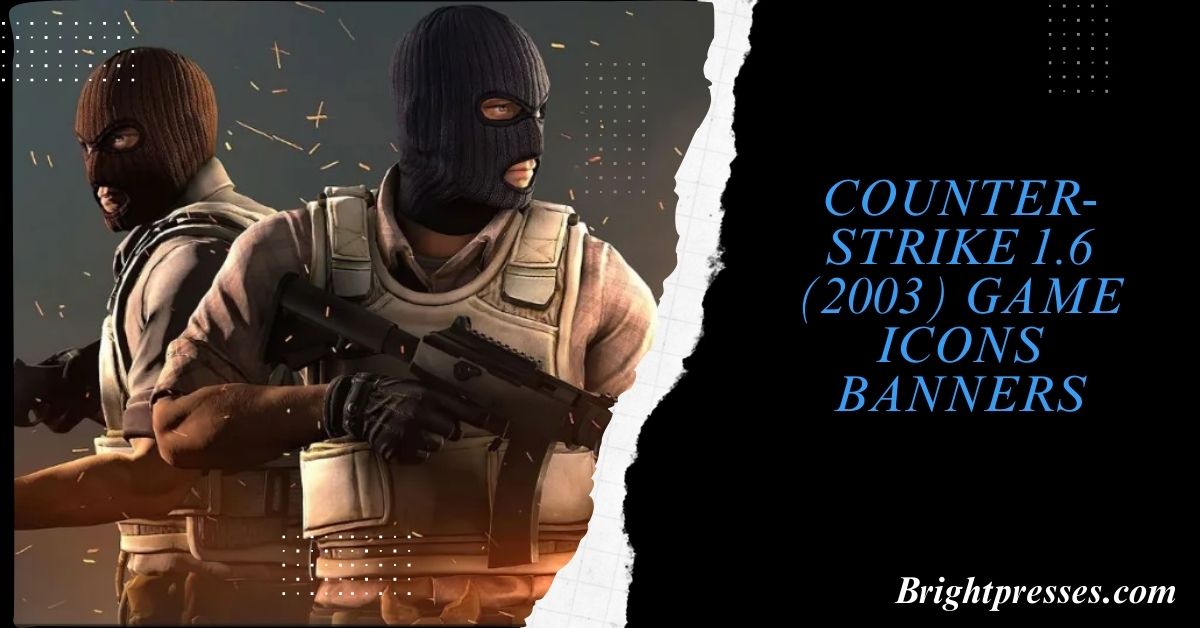Counter-Strike 1.6 (2003) Game Icons Banners – The Ultimate Guide of 2025!
Counter-Strike 1.6 (2003) Game Icons Banners remains one of the most iconic first-person shooters in gaming history. Its intense gameplay, strategic depth, and immersive mechanics make it unique.
The game icons and banners in Counter-Strike 1.6 (2003) played a pivotal role in defining its legacy and shaping gaming culture. These graphics not only enhanced gameplay by making information quickly accessible but also became cultural symbols.
This article explores how Counter-Strike 1.6 (2003) Game Icons Banners and icons shaped the game’s identity, connected with players, and influenced the design of modern games.
The Legacy of Counter-Strike 1.6 (2003)? : How Icons and Banners Defined an Era!
Counter-Strike 1.6 emerged as a groundbreaking title, originally developed as a mod for Half-Life before becoming a standalone game in 2003. The game introduced unique elements of team-based tactics, skill-based gameplay, and fast-paced action.

The icons and banners used throughout the game became symbolic markers that shaped the visual experience and fostering community connections. The icons and banners in Counter-Strike 1.6 (2003) weren’t merely functional because they established a cohesive and recognizable identity.
This visual identity helped Counter-Strike stand out while making it a fixture in competitive gaming and setting a standard in design that future games would follow. The impact of these elements extends into today’s gaming culture influencing everything from UI design to team branding in the esports arena.
Exploring the Core Elements: Game Icons in Counter-Strike 1.6 (2003)!
Design Philosophy of CS 1.6 Game Icons:
The design of game icons in Counter-Strike 1.6 (2003) was built on principles of minimalism and clarity. Each icon was crafted to be immediately recognizable, ensuring that players could process critical information quickly and efficiently. Here is the Iconography Breakdown:
- Weapon Icons: The weapon icons in CS 1.6 were designed to help players switch between firearms smoothly. Each weapon, from the AK-47 to the Desert Eagle, was represented by a distinct, easily identifiable icon. This clear distinction between weapons helped players make instant choices, whether equipping a new weapon or selecting a grenade in a tense moment.
- Armor and Health Icons: Armor and health icons in CS 1.6 held strategic importance, as they allowed players to gauge their resilience in real time. The design of these icons was straightforward and emphasized functionality.
- Utility Item Icons: Utility items, such as smoke grenades, flashbangs, and bombs, were integral to gameplay in CS 1.6. Each item icon used unique visual elements to distinguish it, like the pin on a grenade icon or the explosion symbol.
Usability and Recognition:
The icons in Counter-Strike 1.6 became popular beyond the game. Their simple designs made them symbols for the Counter-Strike community.
These icons showed up in fan art, merchandise, and social media. The easy-to-recognize style helped make the game memorable. Simple design had a big impact on how people played and remembered the game.
The Role of Banners in Counter-Strike 1.6 (2003):
Banner Placement and Purpose:
Banners served a significant purpose in Counter-Strike 1.6, representing the competing teams of Counter-Terrorists and Terrorists.

Displayed prominently at the start of each round, these team banners set the scene for each battle by reinforcing the game’s competitive tone and narrative. They didn’t just identify teams that contributed to the immersive feel of the game.
Team Identity and Rivalry:
The team banners in Counter-Strike 1.6 were more than just symbols for each faction as they created a feeling of rivalry and team pride.
Each banner displayed unique colors and symbols for Counter-Terrorists and Terrorists by allowing players to feel connected to their team while adding a layer of excitement and depth to the game experience.
Visual Storytelling:
By using team banners, CS 1.6 integrated visual storytelling, amplifying the intensity of each match and making players feel part of an epic struggle. This use of banners created another layer of immersion by turning each match into a story within the larger Counter-Strike experience.
Customization and Community Expression in CS 1.6:
The Rise of User-Generated Content:
A key feature of Counter-Strike 1.6 was its support for user-generated content. Players could design custom icons and banners, enhancing their experience and helping to shape the game’s culture. This personalization allowed players to leave a unique mark on the game by fostering a strong community spirit.
Tools for Customization:
Many players used design software like Adobe Photoshop and GIMP to create custom icons and banners. These tools enabled players to craft detailed graphics that represented their in-game personas or clan identities. This customization led to a wide array of player-made visuals, adding to the game’s rich culture.
Notable Community Creations:
Some custom icons and banners became well-known across servers and even beyond the game. Clans and individual players created banners that were widely shared online. These creations have become part of the game’s lore, showing the lasting impact of user-generated content in gaming.
The Cultural and Nostalgic Significance of CS 1.6 Icons and Banners:

Nostalgia in Gaming:
For many players, the icons and banners of Counter-Strike 1.6 (2003) evoke nostalgia, reminding them of early gaming experiences and late-night matches with friends. The visual simplicity and effectiveness of these elements recall a time when gaming was a community-oriented experience, fostering long-lasting connections.
Iconography as Cultural Symbols:
Over the years, the game’s icons and banners have become cultural symbols in their own right. They’re widely recognized and frequently appear in fan art, gaming memorabilia, and online communities. This phenomenon demonstrates the lasting impact of Counter-Strike 1.6 on gaming culture.
Community Reminiscence:
The CS 1.6 community continues to celebrate its iconic visuals, sharing fan art, mods, and personal stories that keep the game’s spirit alive. Engaging readers in this nostalgia strengthens the connection to the game’s legacy, making the icons and banners of CS 1.6 timeless symbols in the world of gaming.
The Design Evolution of Game Graphics – From CS 1.6 to Modern Titles!
Comparative Analysis with Modern FPS Games:
Counter-Strike 1.6 was a pioneer in visual clarity, and its design philosophy has influenced modern FPS games like Valorant and Rainbow Six Siege. These games have adopted similar minimalist design elements, ensuring that icons and HUD elements are both clear and effective.
Adopting Minimalism in Modern Games:
The minimalist approach seen in CS 1.6 icons and banners continues to be a defining characteristic of today’s FPS games. By focusing on clarity and ease of use, these games ensure that players can access crucial information quickly, allowing them to stay focused on gameplay.
Lessons for Future Game Design:
Game designers today can learn from the success of CS 1.6’s iconography. Its emphasis on simplicity and functionality showcases the importance of designing visuals that serve a purpose while enhancing the user experience. The legacy of CS 1.6 remains relevant in shaping the future of gaming design.
A Closer Look at Key CS 1.6 Icons and Their Meanings:
In Counter-Strike 1.6, icons play a crucial role in enhancing gameplay and providing players with essential information. Each icon is designed with purpose, clarity, and style that reflects its unique role within the game.
| Category | Icon Type | Symbol | Purpose | Visual Style |
| Team Roles | Counter-Terrorist Icon | Shield | Represents defense and security | Simple, strong lines |
| Terrorist Icon | Angular design | Represents aggression and offense | Bold, dark colors | |
| Weapons & Tools | Weapon Icons | AK-47, Desert Eagle | Quick weapon recognition | Distinct visuals, minimalistic |
| Grenade Icon | Pin and explosion | Identifies throwable explosives | Clean, clear design | |
| Player Status | Health Icon | Heart/Plus symbol | Displays player health level | Bold, easily readable |
| Armor Icon | Shield or vest | Displays armor level | Simple, highly visible |
Creating Your Counter-Strike 1.6 (2003) Game Icons Banners:

Guide to Customizing Icons and Banners:
Creating custom icons and banners in Counter-Strike 1.6 is a fairly simple process that adds a personal touch to the game experience. Players can use software like Photoshop or GIMP to design unique visuals.
Once designed, save the files in a compatible format (typically .bmp or .tga) and place them in the appropriate game directories to see your custom icons or banners within the game.
Best Practices for Icon and Banner Design:
When designing custom icons and banners, a few best practices can help ensure that they look great and function well in-game:
- Simplicity and Clarity: Design your icons and banners with a focus on simplicity. Icons that are too detailed or busy can be difficult to recognize during gameplay. Aim for clean lines and bold shapes to make icons instantly readable.
- Theme Consistency: Ensure that your custom designs match the overall aesthetic of Counter-Strike 1.6. For example, if you’re designing for a Counter-Terrorist team, use colors and symbols that evoke professionalism and strength such as shades of blue or images of shields.
- Proportion and Size: Icons should be proportionate to fit seamlessly within the game’s interface. Test your icons in-game to make sure they don’t obscure important HUD elements and remain visually clear on various screen resolutions.
- Color Choices: Use high-contrast colors that stand out but are not overly bright or distracting. Colors like black, red, or gray work well and fit with the tactical theme of Counter-Strike.
- Relevance to Gameplay: Make sure each icon represents its function accurately. For example, a grenade icon should resemble a grenade with distinct elements like a pin or blast symbol if possible.
FAQs:
What are some iconic Counter-Strike 1.6 (2003) game icons?
Some iconic game icons in Counter-Strike 1.6 (2003) include the AK-47, Desert Eagle, and grenade icons. These icons represent essential weapons and tools in the game.
What design principles are used in creating Counter-Strike 1.6 (2003) game icons and banners?
The design principles behind Counter-Strike 1.6 (2003) game icons and banners focus on simplicity, functionality, and instant recognition. Each icon was designed to be clear and easy to interpret.
Why is nostalgia important in gaming?
Nostalgia is important in gaming because it connects players to fond memories of their past experiences, often associated with friendships, late-night matches, and favorite games.
How did Counter-Strike 1.6 (2003) influence modern gaming?
Counter-Strike 1.6 (2003) influenced modern gaming by setting standards for team-based gameplay, clear iconography, and competitive online play.
Where can I find these iconic Counter-Strike 1.6 (2003) game icons and banners?
You can find these iconic Counter-Strike 1.6 (2003) game icons and banners in the original game files or by exploring dedicated gaming forums and fan sites. These visuals are often shared by fans and modders who appreciate the history and legacy of Counter-Strike 1.6.
Can I create custom banners for my CS 1.6 server?
Yes, players can create custom banners for their CS 1.6 servers. By using image editing software, you can design unique banners that reflect your server’s identity
Conclusion:
Counter-Strike 1.6 (2003) Game icon banners played a vital role in shaping the game’s identity and enhancing players’ experiences. Their simple, functional designs helped players quickly interpret essential game information, such as team roles and equipment status while enhancing the game’s immersive feel.
These visuals became memorable symbols beyond gameplay, representing a time in gaming that united players in communities worldwide. Even today, Counter-Strike 1.6 (2003) game icons and banners carry a nostalgic value that reminds the fans of the game’s lasting impact on gaming culture and design.














Post Comment